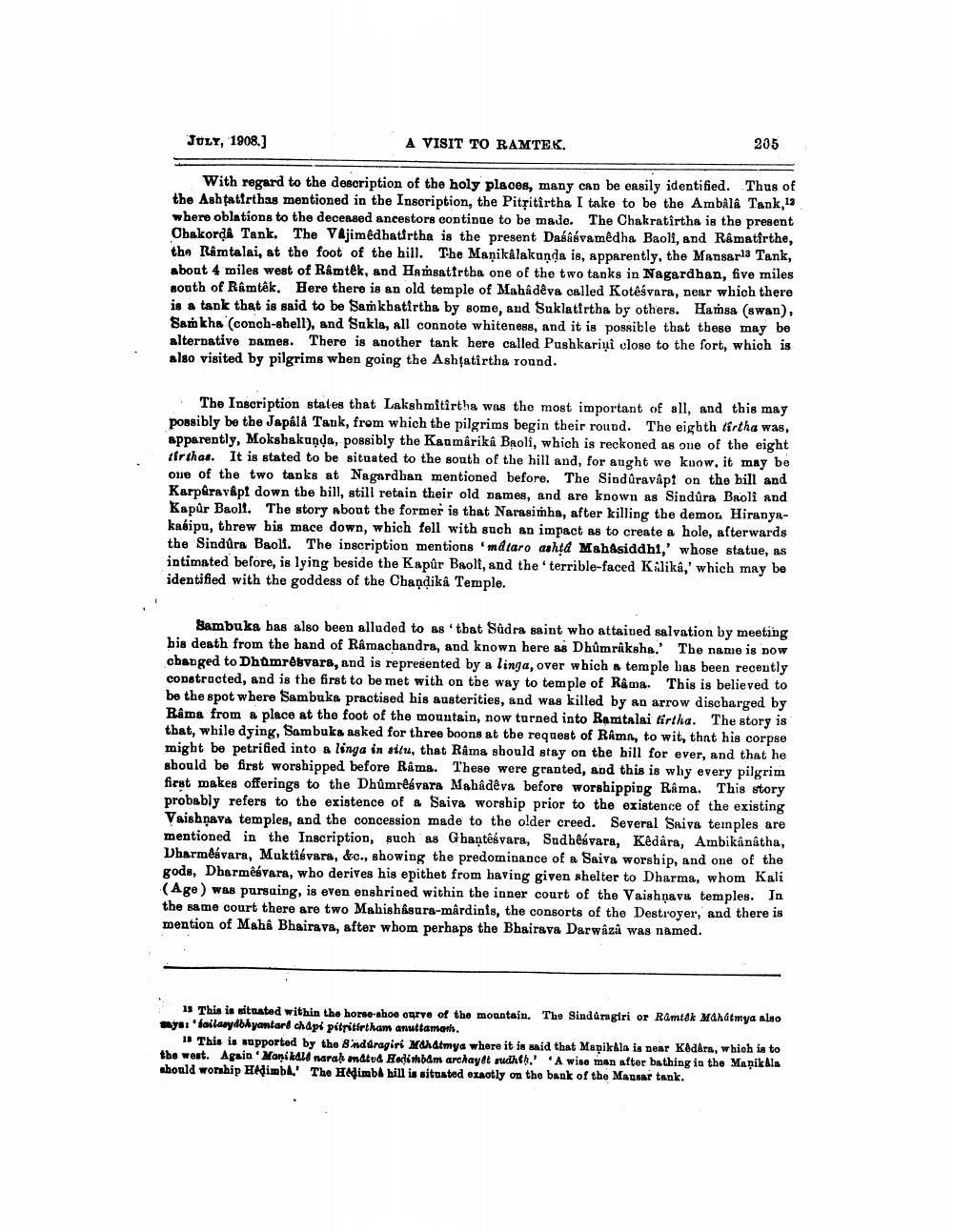________________
JULY, 1908.)
A VISIT TO RAMTEK.
205
With regard to the description of the holy places, many can be easily identified. Thus of the Ashtatirthas mentioned in the Insoription, the Pitsitirtha I take to be the Ambâlâ Tank,13 where oblations to the deceased ancestors continue to be made. The Chakratîrtha is the present Obakorda Tank. The Vajimêdhatirtha is the present Daśksvamêdha Baoli, and Râmatirthe, tha Râmtalai, at the foot of the hill. The Maņikálakunda is, apparently, the Mansar13 Tank, about 4 miles west of Rámtêk, and Hamsatirtha one of the two tanks in Nagardhen, five miles Bonth of Rimtêk. Here there is an old temple of Mahadeva called Kotêśvara, Dear which there is a tank that is said to be Samkbatirtha by some, and Suklatirtha by others. Hamsa (swan), Sankhs (conch-shell), and Sakla, all connote whiteness, and it is possible that these may be alternative names. There is another tank here called Pushkariņi close to the fort, which is also visited by pilgrims when going the Ashtatirtha round.
· The Inscription states that Lakshmitirtha was the most important of all, and this may possibly be the Japála Tank, from which the pilgrims begin their round. The eighth tirtha was, apparently, Mokshakuņda, possibly the Kaamârika Baoli, which is reckoned as one of the eight tfr thas. It is stated to be situated to the south of the hill and, for aught we know, it may be ove of the two tanks at Nagardban mentioned before. The Sindûravâpt on the bill and Karperav&pt down the hill, still retain their old names, and are known as Sindura Baoli and Kapúr Baolt. The story about the former is that Narasimha, after killing the demor. Hiranyakabipu, threw his mace down, which fell with such an impact as to create a hole, afterwards the Sindura Baoli. The inscription mentions'mdtaro ashtå Mahasiddhi, whose statue, as intimated before, is lying beside the Kapûr Baoli, and the terrible-faced K Jika,' which may be identified with the goddess of the Chandika Temple.
Sambuka has also been alluded to as that Sadra saint who attained salvation by meeting his death from the hand of Ramachandra, and known here as Dhúmraksha.' The name is now changed to Dhamrêsvars, and is represented by a linga, over which a temple has been recently constructed, and is the first to be met with on the way to temple of Rama. This is believed to be the spot where Sambuka practised his austerities, and was killed by an arrow discharged by Rama from a place at the foot of the mountain, now turned into Ramtalai tirtha. The story is that, while dying, Sambuka asked for three boons at the request of Ramn, to wit, that his corpse might be petrified into a linga in sitrı, that Rama should stay on the hill for ever, and that he should be first worshipped before Râma. These were granted, and this is why every pilgrim first makes offerings to the Dhûmrésvara Mahadeva before worshipping Rama. This story probably refers to the existence of a Saiva worship prior to the existence of the existing Vaishnava temples, and the concession made to the older creed. Several Saiva teinples are mentioned in the Inscription, such as Ghantêsvara, Sudhêsvara, Kedara, Ambikânâtha, Dharmêsvara, Muktisvara, &c., showing the predominance of a Saiva worship, and one of the gods, Dharmêsvara, who derives his epithet from having given shelter to Dharma, whom Kali (Age) was pursuing, is even enshrined within the inner court of the Vaishnava temples. In the same court there are two Mahishasura-mârdinis, the consorts of the Destroyer, and there is mention of Maha Bhairava, after whom perhaps the Bhairava Darwaza was named.
13 This is situated within the horse-hoe ourvo of the mountain. The Sinddragiri or Ramtek Mahatmya also mysi failasabhyantari chapi pitritirtham anultamani.
13 This is supported by the B'nddragiri Mahatmya where it is said that Mapikala is near Kidkra, which is to the west. Again Marikala narab matud Redirbam archayét much.' 'A wise man after bathing in the Maạikala should worship Hadimba The Hadimba hill is situated exactly on the bank of the Mausar tank.




